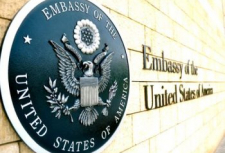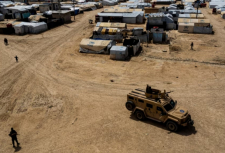The Lost Sanjaq. Part 1

Peter Nicolaus
United Nations High Commissioner for Refugees, Tbilisi
Sanjaqs-the most evident symbol of yezidi religion
The term sanjaq in the language of the Yezidis, means the sacred effigy of a bird mounted on a stand, which resembles a candlestick frequently seen in oriental Christian churches. The figure, as well as the stand are made of bronze or brass and consist of several pieces so that the sanjaq can be dismantled for transportation. The known sanjaqs measure about 50 to 80 cm in length and weigh 4 to 7 kg.
The seven sacred images are “the most concrete expression of Yazidism” (Menzel 1938: 1165) and each of the birds symbolises one of the seven supreme angels, which constitute the Yezidi heptad of divine beings. Each of the seven sanjaqs is named after one of the seven archangels, or rather after individuals, who attained divinity through transmigration of the soul of the respective archangel. The fact that each sanjaq is identified with one of the seven archangels is also confirmed by information obtained from members of the Yezidi community in Iraq, Armenia, and Georgia. Almost all Yezidis interviewed in this context corroborate, regardless of their caste, gender and educational back ground, that each sanjaq would correspond with one of the seven archangels and that they, therefore, would look quite different.
During the display of the sanjaq the head qewal preaches a sermon, and then the qewals recite qewls accompanied by the sacred instruments of Yezidism, the def (tambourine) and shibab (flute). The believers approach the sacred image, kiss it full of devotion, and leave some money next to it. Non-Yezidis are not allowed to attend the ceremony and so far only a handful of non-believers have ever seen a sanjaq though this practice of secrecy has become less strict during the last 20 years.
Tags: #yazidisinfo #ezidi #yazidi #aboutezidi #symbolofreligion
The Lost Sanjaq. Part 1

Peter Nicolaus
United Nations High Commissioner for Refugees, Tbilisi
Sanjaqs-the most evident symbol of yezidi religion
The term sanjaq in the language of the Yezidis, means the sacred effigy of a bird mounted on a stand, which resembles a candlestick frequently seen in oriental Christian churches. The figure, as well as the stand are made of bronze or brass and consist of several pieces so that the sanjaq can be dismantled for transportation. The known sanjaqs measure about 50 to 80 cm in length and weigh 4 to 7 kg.
The seven sacred images are “the most concrete expression of Yazidism” (Menzel 1938: 1165) and each of the birds symbolises one of the seven supreme angels, which constitute the Yezidi heptad of divine beings. Each of the seven sanjaqs is named after one of the seven archangels, or rather after individuals, who attained divinity through transmigration of the soul of the respective archangel. The fact that each sanjaq is identified with one of the seven archangels is also confirmed by information obtained from members of the Yezidi community in Iraq, Armenia, and Georgia. Almost all Yezidis interviewed in this context corroborate, regardless of their caste, gender and educational back ground, that each sanjaq would correspond with one of the seven archangels and that they, therefore, would look quite different.
During the display of the sanjaq the head qewal preaches a sermon, and then the qewals recite qewls accompanied by the sacred instruments of Yezidism, the def (tambourine) and shibab (flute). The believers approach the sacred image, kiss it full of devotion, and leave some money next to it. Non-Yezidis are not allowed to attend the ceremony and so far only a handful of non-believers have ever seen a sanjaq though this practice of secrecy has become less strict during the last 20 years.
Tags: #yazidisinfo #ezidi #yazidi #aboutezidi #symbolofreligion


























